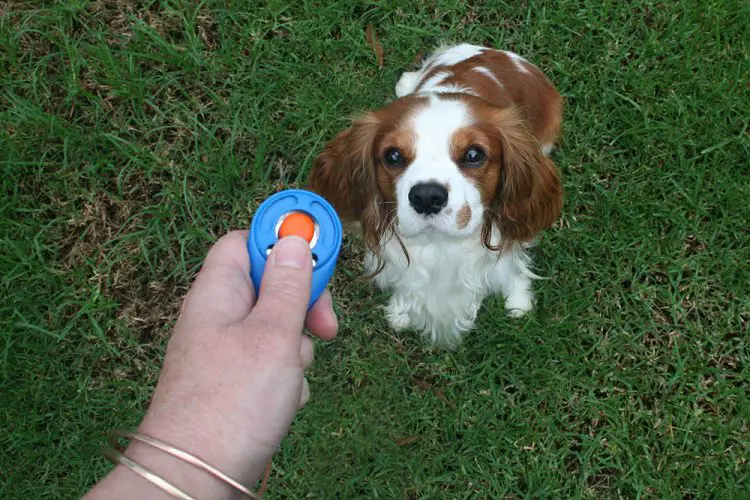Last Updated: 2 years ago
When attempting to train your dog, there are a variety of different methods which are popular to use.
Two of these methods are using a dog clicker and using a training collar. In this post, we’ll discuss how to clicker train a dog as well as how a training collar works and compare the effectiveness of the two methods.
What Is A Dog Clicker?
A dog clicker is essentially a small plastic toy that makes a clicking sound.
When training your dog in new behavior, the clicker acts as a way to quickly identify (or “mark”) the dog which behaviors will earn them a treat. Of course, once the behavior has been completed and marked, you still have to give the dog a treat!
The premise of clicker training is that it shows your dog very clearly which behavior will earn them a treat.
Once the click has been associated with the delivery of a treat, the click itself (without a treat attached) will begin to get the dog’s attention, acting as a reward in itself.
Pros And Cons Of Clicker Training
Pros
- It can be done (with some practice) by anyone and doesn’t require a professional trainer.
- The only equipment needed is a plastic clicker and a supply of treats.
- Another benefit of clicker training is that the dog will remember behavior from one session to the next. This gives the trainer some room for flexibility in how they train.
- Unlike using your voice, there is less of an emotional exchange with the dog. As a result, the animal does not associate their behavior with your approval or disapproval, just whether or not it’ll be rewarded for it.
- Training sessions with a clicker can also last longer than sessions that use negative reinforcement without worry about your dog’s health (either physical or emotional).
Cons
- Dogs with a low drive towards food or toys will be more difficult to clicker train.
- There is a bit of technique necessary for successful clicker training, which mostly has to do with timing.
- If you don’t make clear to the dog which behavior is being rewarded, the training will either not stick or just become confusing to the dog.
Basics Of Clicker Training
The first step in clicker training is what’s known as “charging the clicker.” Charging the clicker means forming a connection in your dog’s mind between the clicker and a treat. Food is the most commonly used treatment. If you have ever spent time with a dog, it’s not hard to understand why.
To begin charging the clicker, grab a handful of your dog’s favorite treats. Next, press the clicker, and immediately afterward, reward your dog. Try this 15 times and repeat it for three different sessions throughout the day.
This first step does not require any training, just clicking and rewarding.
Once you’ve charged the clicker, here are some commands you can teach your dog:
- Stay – Whenever your dog is sitting still, go ahead and click once
- Go to your place– As you teach your dog to go to their bed or cage, click for them
- Jump– When your dog jumps, you can give them a click
Tips to remember when clicker training:
- Be sure to reward your dog with a treat as well as clicking
- Only give one reward per click
- Be sure to deliver the treat within 3 seconds of clicking
- Click for the action, then reward when they’ve completed it
What Is A Training Collar?
An alternative to clicker training is to use a training collar.
In the case of a training collar, when you push a button on a remote control, your dog will receive a small amount of electric charge from their collar. This remains a controversial training technique, especially with groups like the Humane Society.
Some of the negative associations include a tendency towards abuse as well as dogs developing the wrong associations, such as with people or surroundings rather than unwanted behavior.
Dog Clicker Vs Training Collar

The main difference between the two is the difference between training through negative reinforcement versus positive reinforcement.
Negative reinforcement means, in so many words, punishing your dog for negative behavior, whereas positive reinforcement means rewarding them for the behavior you want.
The advantages of either are a source of constant debate in both the dog training community as well as the world of psychology at large.
One of the main benefits of using a training collar is being able to control your dog when he/she is off the leash.
If you and/or your dog enjoy time off the leash when at the park, beach, or on a walk, collar training may be beneficial. Picture your dog is off the leash and about to run into a busy street – being able to stop them remotely has the potential to save their life.
Contrary to popular opinion, training collars are not necessarily damaging to your dog’s health, especially when they are set to the lowest, least harmful setting.
An electric charge from a collar can be merely a signal to your dog, no more harmful than grabbing them by the collar. These days, collars come equipped with anywhere between 4 and 50 different settings.
When properly employed, a training collar can be just as effective and no more harmful than using a clicker to train your dog. In addition, the dog will not associate the charge with their owner, but with its own behavior, and act accordingly.
Again, when used properly, the main difference between clicker training and using a training collar is that both can be used to train your dog to obey basic commands as well as to curb unwanted behavior, but a training collar can be used at long-range, where a clicker cannot.
Conclusion
Despite the fact that the debate continues, there are benefits to both clicker training and training with a collar.
Some experts even suggest using both for maximum results. We suggest you try what feels most natural for you and your dog and adjust accordingly if your first choice is not working.
Resources:



